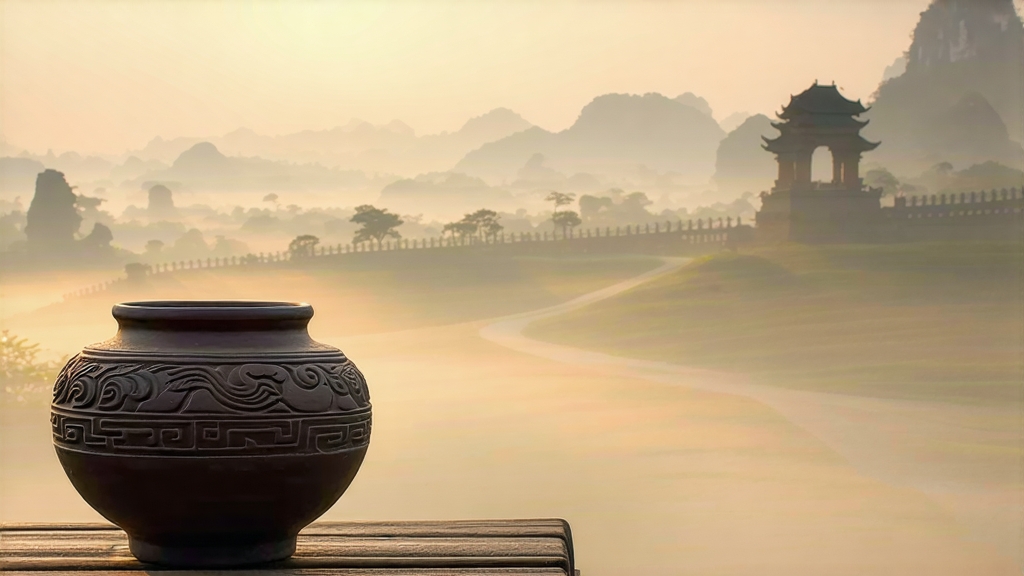
Liu Bao cha, literally “Six Forts tea,” is the quietest celebrity of China’s dark-tea family. While Pu-erh grabs headlines and Fu zhong wins hearts with its golden flowers, Liu Bao has spent four centuries maturing in clay jars, sailing on bamboo rafts down the Liu River, and calming the digestion of dock workers from Wuzhou to Kuala Lumpur. To meet it is to step into a living archive of taste, trade, and terroir that links the misty karst peaks of Guangxi to the spice-scented kopitiams of Southeast Asia.
History: From Border Garrison to Global Cup
The name Liu Bao refers to the six ancient fortresses that once guarded the mountain passes of Cangwu County, eastern Guangxi. During the Qing Yongzheng era (1723–35), imperial edicts encouraged the conversion of Sichuan and Guangxi military farms into tea gardens to supply the frontier garrisons. The tea pressed into baskets and shipped downriver proved so effective at preventing dysentery among soldiers and dockers that it was soon bartered for horses on the Tea-Horse Road’s southern branch. By the late nineteenth century, Liu Bao had become a currency in its own right: one basket (about 55 kg) could buy half a ton of Malayan tin ore. Chinese coolies working in the Straits Settlements were paid partly in Liu Bao, and the tea’s mellow, earthy liquor became the taste of home for a diaspora that carried it as far as Johannesburg and the Calcutta docks. When the Pacific War severed supply lines, Malay miners hoarded leftover leaves like gold dust; after the war, returning migrants re-introduced the tea to Guangxi, completing a 20,000-kilometre round trip that still shapes its microflora.
Terroir: Where Karst Meets River
Liu Bao’s native range is a 500-metre-high belt of red and yellow latosol squeezed between the Qinzhou plain and the Dayao Mountains. The soil is poor—acidic, ferric, and fast-draining—forcing tea bushes (predominantly a large-leaf cultivar related to Camellia sinensis var. assamica) to drive roots deep into limestone fissures. The resulting leaves are thick, waxy, and rich in pectin, the perfect substrate for the successive microbial consortia that will later sculpt the tea’s flavor. Fog drifts up the Liu River every morning, reflecting ultraviolet light and slowing photosynthesis; the stress concentrates amino acids and polyols, giving Liu Bao its signature sweet-balsamic finish. Locals insist that the same tea moved 50 km north loses its “river rhyme,” a sensory echo of running water said to linger in the throat.
Harvest Calendar: Picking the Thunder
The picking season opens on the third day after the first spring thunder, usually around Qingming. Only the “three opens” standard is accepted: the bud, the first leaf half-unfurled, and the second leaf fully open. Workers pinch sideways to keep the tiny fish-leaf (the first scale-like leaf) attached; this sliver will later turn amber during fermentation and release a hint of jackfruit. Summer rains bring a second flush in June, but the most prized material is the “autumn spear” picked in late September when nights are cooler and river mist thickens. These leaves carry fewer bitter catechins and more aromatic geraniol, laying the groundwork for the tea’s camphor-note vintage.
Craft: The Secret Life of Stacks
Withering is done outdoors on bamboo screens angled toward the river. For three hours, tea masters shuffle the leaves every seven minutes, coaxing moisture down to 68 %. The real signature of Liu Bao is “dui zi” (wet stacking), a Guangxi cousin of Wo-dui but gentler and longer. The leaves are sprayed with mineral-rich spring water, piled 70 cm high, and covered with jute sacks weighted down by river stones. Core temperature is kept below 55 °C for twenty-five days, low enough to favor yeasts such as Cyberlindnera jadinii that produce ethyl phenylacetate (honey-rose aroma) while discouraging harmful molds. Every third night the pile is turned by barefoot workers who claim they can “listen” for the right crackle. When the leaf veins turn walnut-brown and a betel-nut fragrance rises, the tea is sun-dried for one day, then steamed and pressed into 40 kg bamboo baskets lined